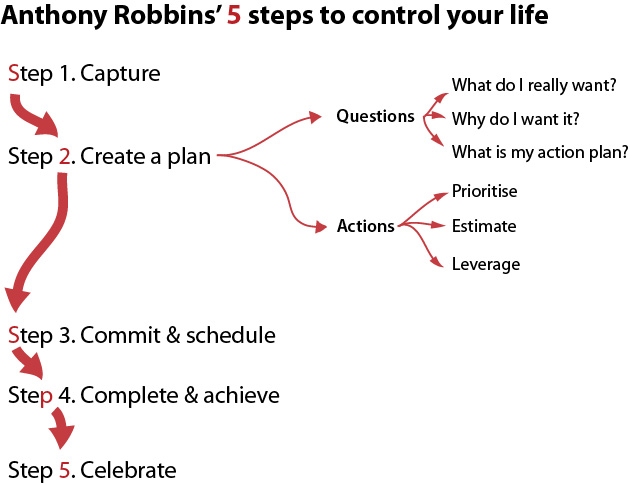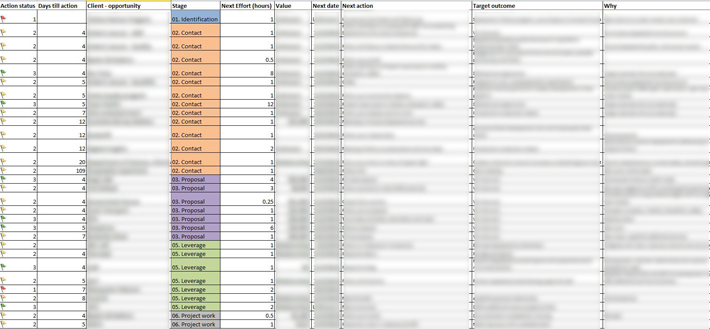Anthony Robbins’ five steps to control your life, with a practical sales spreadsheet example

Can you gain control in your life in just five steps? Anthony Robbins says it is likely if you follow practices he outlines in part one and part two of a business executive session.
Before we begin
I will offer a few caveats before I summarise the five steps.
First, many consider Anthony Robbins to be either a self-help caricature or a self-help icon. If you fall into either category, I encourage you to set aside any preconceptions so as to not let the person get in the way for any value you might get from the message.
Second, it can seem unrealistic to think that control can come in just five steps by following some “n-step” model. I propose that if life does seem out of control, doing nothing will produce the same results.
Third, you may dismiss value by thinking you can’t make a substantial difference in your life by simply watching a free YouTube video (or reading a blog post). I am learning to take value where I find it. If it is “free”, then the only cost is your own emotional investment. With that in mind, you get out what you put in.
Fourth, the model is simplistic and appears as “common sense”. I find common sense is often identified but not found in common practice. This is a self-reflection as much as an observation of others.
Finally, the outline aligns with my previous posts around goal setting theory, strategic planning, and the organisational whirlwind. This is not to say Robbins is right because he agrees with me or visa versa, but at least the model appears to align with a general consensus from academic literature and mostly-popular opinion.
Five steps to control your life (or at least to know what you are dealing with)
Step 1: Capture
Find one place to capture everything that comes to mind and group those items into categories. This place may be paper, your smartphone, an Excel spreadsheet, or a free online tool such as Trello. The important thing is to get it out of your head into a place that is easy to access. Items floating in your head create stress. Stress is reduced once they are in a list in front of you.
Step 2: Create a plan
The plan is structured into three questions and three actions.
Question 1: What do I really want?
Get clear about the outcomes and make the results measurable.
Question 2: Why do I want them?
Be clear, as your language shapes your emotion. Be clear, as activity without purpose is the drain to life.
Question 3: What is my action plan?
If you do not have an action plan, what you do is based on stress and reaction.
Action 1: Put in order of importance
What is the 20% that will give you 80% of the results. These are your “must” items.
Action 2: Establish the real time
What is the amount of effort you feel will be necessary to get this done?
Action 3: Leverage
Who can help get this done and can benefit from being involved?
Step 3: Commit and schedule
Now that the outcome blocks are defined, commit to the most important things and schedule the times.
Step 4: Complete and achieve
Follow through on doing what you scheduled yourself to do.
Step 5: Celebrate
Celebrate the victories, as celebration is what gives you the energy to go for more. If you do not give yourself credit, your brain does not notice it.
Putting into practice
The complexities of life do not always need a complex solution. The model above is simple yet effective and I expect aligns with many things you are already doing. I gave myself a week to see if I could apply something from the model to my life.
I had a play with regards to an Excel spreadsheet I use as part of the client-facing function of my role. I am aware of the plethora of customer relationship management systems and applications. I also have another business-level system to keep track of my history and reporting, but I tend to use Excel as an easy tool to keep track of top of mind tasks.

Here is how my spreadsheet is structured:
- Action status
Three options:
1) No action. Very few items will be in this state. The item is dependent upon something which I have no control over and I am not accountable for in any way. I need to be aware of it but I will spend any energy on it apart from being aware that it exists.
2) Action later. There is action scheduled in the future such as a meeting or follow up phone call, but there is nothing for me to do on this now.
3) Action required. If I choose, I can apply energy towards this item now and make a difference in the outcomes. - Days till action
A calculated field of the difference from today to the “Next date” field. - Client – opportunity
The name of the client and the opportunity or project. Keep in mind that a client can have multiple opportunities and an opportunity may be in multiple stages. - Stage
For me, this is the sales stage. Most things we keep track of are in various states of 1) Identification, 2) Contact, 3) Proposal or definition, 4) Engagement, 5) Leverage, or 6) Project work. I use conditional formatting to colour code so I can at a glance see where the majority of my effort is focused. - Next effort (hours)
How many hours I expect to spend getting the opportunity to the next action. Do not consider that this will occupy you for two weeks over the length of the opportunity. Only consider what is next. Overall success is defined by successfully completing a series of small steps. I can then add up all hours required for the next 10 days to assess how realistic I am in thinking I will complete everything by the dates I promise. - Value
The value of the opportunity. This acts like the priority mentioned by Robbins. - Next date
The date the effort is due. - Next action
- This is a quick statement about what is needed next, such as “follow on email” or “write proposal”.
- Target outcome
This is the “What do I really want” from Robbins. Before the phone call or meeting, I remind myself that if I leave the meeting or phone call and do not achieve this thing, then I will not have achieved my objective. This is an important clarification, in that the purpose of the phone call is not to secure a new account or negotiate a new contract. The purpose of the phone call is to get a meeting, the purpose of the meeting is to define the opportunity, and the culmination of a series of successful opportunities may be to secure the account. Take one step at a time, but be crystal clear about that next step. - Why
This is Robbins’ “Why do I want this”. What will you say if whoever you report to (yourself if you run your own business) reviews your spreadsheet and asks why you are spending energy on this particular opportunity? What sets this item apart? Get beyond simply “Increase revenue”. What makes this particular opportunity important? If you are clear about why this is important to you, everyone else will make it important to them for the same reason.
Each morning, I clear out all my Action Status 2’s and 3’s and re-assess. I confirm in the schedule of my day what 3’s I am going to get through. I am then able to get a small sense of satisfaction and celebration as I make my 3’s into 2’s by progressing opportunities towards the outcome.
Robbins’ five steps are not revolutionary, but following a framework of some sort can help bring order to chaos. Do you manage multiple tasks across multiple stages? Is Robbins’ model too simplistic and common sense? If so, do you do what is common? I would be interested in hearing what you use to keep track of the day to day details.
If you have time, please add “comment on the Sideways Thoughts blog post” to your Capture list and I will Celebrate with you after you Complete and achieve.

I like the way you have captured and summarised the framework. Thank you!